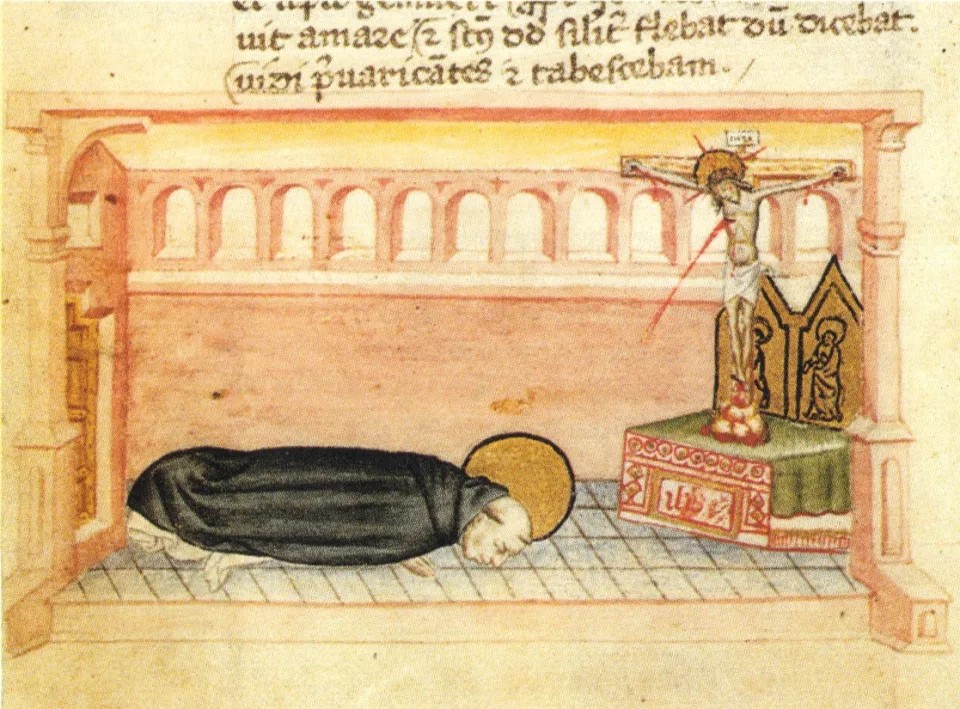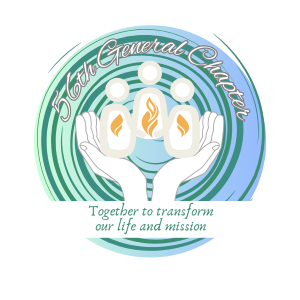Let's pray for each other
- by Dominicas
-
in News
-
Hits: 421

La Grande Bretèche (Tours), 07/24/2024, Sr. Gemma Morató i Sendra and Sr. Conchi García Fernández - www.domipresen.com.- The retreat continues in an atmosphere of silence and prayer. Sister Catherine Aubin continues her preaching on the ways of praying of Saint Dominic.
Accompanied by the Holy Spirit, we will pray for each other to enter that upper room, that interior castle, the cell, as Saint Catherine of Siena said. It is good to make the effort to visualize this place. Catherine asks Jesus: “Why are you crying?” and Jesus replies: “Because I see the freedom of man who is telling me ‘No’.”
Sister Catherine comments that in the icons of the nine ways of praying, the Virgin Mary is always subtly present. That is why praying the Rosary is like the low note in polyphony, which supports our journey. Mary teaches us to unite with God, to have unconditional trust in Him, but also to question and dialogue with Him. Thus, we have strength in our model, Mary. It is learning to have trust, memory, union with God, and interiority.
What distances us from the Source is everyday life, dispersion, and certain addictions: the phone, sweets... everything that leads us outward, highlights the Dominican of the Roman Congregation of Saint Dominic. We fear God, fear not being up to par, fear being judged. Thérèse of Lisieux gives us great confidence: we reach heaven with empty hands and let the Lord fill them.
Another problem is forgetfulness, negligence, laziness. Saint Bernard expresses that the great sin is forgetting what God has done for us. The word "remember" appears 365 times in the Bible, therefore, once for each day of the year.
Second way of praying: from prostration to compunction of the heart

The second way of praying is a continuation of the first. What does Dominic do on the ground? What does he tell us? Where are we? Show us, Dominic, the way!
He is touched by compunction: “Have mercy on me, for I am a sinner!” He recalls David's words: "It is I who have sinned," and weeps. Dominic teaches us that if we cannot weep for our own sins because we do not recognize them, we can present and weep for the sins of many others.
The preacher affirms that we must start from an anthropology that recognizes the body, soul, and heart. The place of emotions is the soul, and the heart is the place of prayer, discernment, and decision.
Saint Dominic sees Jesus weeping over Jerusalem. We have ears and do not understand, we have eyes and do not see... Dominic prostrates himself entirely on his face, it is a radical gesture before God (see Psalm 144). What leads him to prostrate? With whom does he identify? With the publican, the one who cannot lift his eyes... who strikes his heart so that it opens and water flows, as Saint Augustine says.
We are blind, and this prevents us from weeping and praying. It is pride. Our sisters know our blindness very well, but if we ourselves do not recognize it, it is very difficult.
Entering the compunction of the heart, we see it in Saint Peter when, on Holy Thursday, he says, "I will follow you" and Jesus warns him. Did Peter hear it? And Peter, in front of the women, denies Jesus three times and then Christ arrives. When they look at each other, Peter sees his betrayal and sees Christ's unconditional love despite his betrayal.
The compunction of the heart is not despair or disappointment, it is not an emotion, it is a refocusing, it is a metanoia. We prostrate ourselves to go in another direction.
The evening begins with the reading of a life testimony that illuminates how the Holy Spirit speaks to us today. A father of a family, in the middle of nowhere and hungry, hears Jesus within him and exclaims: "Lord, speak to me in the silence. Are you sad, alone?" And the Lord replies: "I have been living with you for many years and I am a prisoner. I need your ears, your eyes, and your mouth… I have nothing, I am a prisoner in you." And the father replies: "Lord, I lend you everything so that you can listen, see, and speak. I want to be a walking tabernacle; I want to live your presence in me." And so, everything is beautiful, everything is simplified. Make us return to you, Lord!
We move forward. On the spiritual plane, the gaze reveals our source; it is the mirror of the soul. On the other hand, "in videre" (envy, jealousy) is the disease of looking wrongly. The entire Bible is traversed by this sin, from Cain and Abel to the Cross. This starts in the family and in close relationships; we are not jealous of someone far away, but of the “neighbor.” Jealousy is fought in the heart. If we leave the door open to it, we will lie, steal, be adulterers, and “kill our neighbor.” We can kill with the look and with the word. And the origin is the eye, the gaze, the source of the gaze.
Saint Dominic sees Christ crying, recognizes that he is touched by compunction. We must not grieve the Holy Spirit. Dominic receives the light of Truth. Compunction is sadness without anguish, it is not despair, it is not acedia. It is a call to look differently. Tears are the link between the body and the spiritual. They open to repentance. It is not guilt, it is a change of spirit, a transformation of our perspective. It is an act of great intelligence. It is not an emotional crisis.
We must look up. It is an illumination; it is passing from darkness to light. To repent is to open our eyes to the light of God. We must recognize that the Kingdom is among us and look toward God's love. It is a permanent, unfinished attitude. It is impossible to see what is not working without the light of Christ. What is more important, to raise a dead person or to see one's own sin?
Dominic's tears are knowledge, renunciation of judgment. He is decentralized from himself, looks at others. "You have taken everything from me, I have nothing left, only the thirst for God is in me as a desire, I have nothing but this thirst."
Tomorrow, we continue. We let the Spirit fill our hearts.
The video of the day


